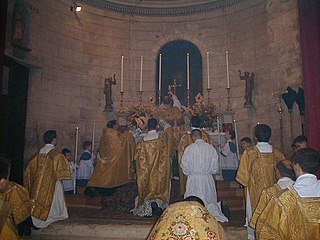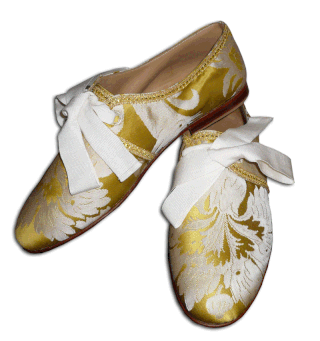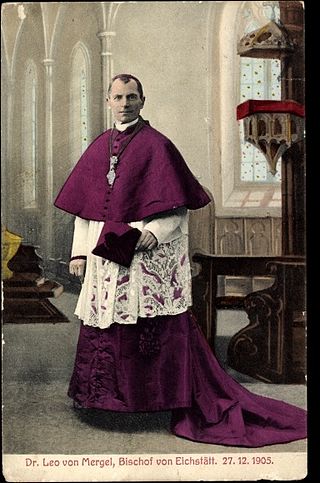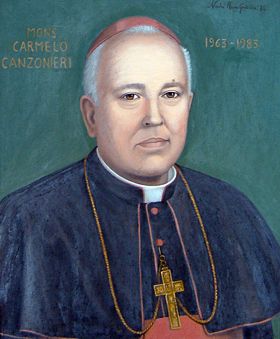
The cassock or soutane is a Christian clerical clothing coat used by the clergy and male religious of the Oriental Orthodox Churches, Eastern Orthodox Church and the Catholic Church, in addition to some clergy in certain Protestant denominations such as Anglicans and Lutherans. "Ankle-length garment" is the literal meaning of the corresponding Latin term, vestis talaris. It is related to the habits traditionally worn by nuns, monks, and friars.

Vestments are liturgical garments and articles associated primarily with the Christian religion, especially by Eastern Churches, Catholics, Lutherans, and Anglicans. Many other groups also make use of liturgical garments; among the Reformed (Calvinist) Churches this was a point of controversy in the Protestant Reformation and sometimes since, in particular during the ritualist controversies in the Church of England in the 19th century.

The mitre or miter is a type of headgear now known as the traditional, ceremonial headdress of bishops and certain abbots in traditional Christianity. Mitres are worn in the Catholic Church, Eastern Orthodox Church, Oriental Orthodox Churches, the Anglican Communion, some Lutheran churches, for important ceremonies, by the Metropolitan of the Malankara Mar Thoma Syrian Church, and also, in the Catholic Church, all cardinals, whether or not bishops, and some Eastern Orthodox archpriests.

A cope is a liturgical long mantle or cloak, open at the front and fastened at the breast with a band or clasp. It may be of any liturgical colour.

Monsignor is a form of address or title for certain members of the clergy in the Catholic Church. Monsignor is the apocopic form of the Italian monsignore, meaning "my lord". "Monsignor" can be abbreviated as Mons. or Msgr. In some countries, the title "monsignor" is used as a form of address for bishops. However, in English-speaking countries, the title is unrelated to the episcopacy, though many priests with the title later become bishops.

A galero is a broad-brimmed hat with tasselated strings which was worn by clergy in the Catholic Church. Over the centuries, the red galero was restricted to use by individual cardinals while such other colors as black, green and violet were reserved to clergy of other ranks and styles.

A rochet is a white vestment generally worn by a Roman Catholic or Anglican bishop in choir dress. It is unknown in the Eastern churches. The rochet in its Roman form is similar to a surplice, except that the sleeves are narrower. In its Anglican form it is a descendant of the traditional albs worn by deacons and priests. In the Roman Catholic tradition, the rochet comes below the knee and its sleeves and hem are sometimes made of lace; in the Anglican tradition, the rochet comes down almost to the hem of the cassock and its sleeves are gathered at the wrist.

A chimere is a garment worn by Anglican bishops in choir dress, and, formally as part of academic dress.

Papal regalia and insignia are the official items of attire and decoration proper to the Pope in his capacity as the visible head of the Catholic Church and sovereign of the Vatican City State.
A Prelate of Honour of His Holiness is a Catholic prelate to whom the Pope has granted this title of honour.

Episcopal sandals, also known as pontifical sandals, are a Catholic pontifical vestment worn by bishops when celebrating liturgical functions according to the pre–Vatican II rubrics, for example a Tridentine Solemn Pontifical Mass.

A pectoral cross or pectorale is a cross that is worn on the chest, usually suspended from the neck by a cord or chain. In ancient history and the Middle Ages, pectoral crosses were worn by both clergy and laity. By the Late Middle Ages, the pectoral cross came to be a special indicator of position worn by bishops. In the Roman Catholic Church, the wearing of a pectoral cross remains restricted to popes, cardinals, bishops and abbots. In Eastern Orthodox Church and Byzantine Catholic Churches that follow a Slavic Tradition, priests also wear pectoral crosses, while deacons and minor orders do not. The modern pectoral cross is relatively large, and is different from the small crosses worn on necklaces by many Christians. Most pectoral crosses are made of precious metals and some contain precious or semi-precious gems. Some contain a corpus like a crucifix while others use stylized designs and religious symbols.

Choir dress is the traditional vesture of the clerics, seminarians and religious of Christian churches worn for public prayer and the administration of the sacraments except when celebrating or concelebrating the Eucharist. It differs from the vestments worn by the celebrants of the Eucharist, being normally made of fabrics such as wool, cotton or silk, as opposed to the fine brocades used in vestments. It may also be worn by lay assistants such as acolytes and choirs. It was abandoned by most of the Protestant churches that developed from the sixteenth-century Reformation.

The papal shoes are the red leather outdoor shoes worn by the Pope. They are distinct from the indoor papal slippers or the Episcopal sandals, which are the liturgical footwear proper to all ordained Catholic bishops of the Latin Church.

The mozzetta is a short elbow-length sartorial vestment, a cape that covers the shoulders and is buttoned over the frontal breast area. It is worn over the rochet or cotta as part of choir dress by some of the clergy of the Catholic Church, among them the pope, cardinals, bishops, abbots, canons and religious superiors. There used to be a small hood on the back of the mozzetta of bishops and cardinals, but this was discontinued by Pope Paul VI. The hood, however, was retained in the mozzette of certain canons and abbots, and in that of the popes, often trimmed in satin, silk or ermine material.
In the Roman Catholic Church, protonotary apostolic is the title for a member of the highest non-episcopal college of prelates in the Roman Curia or, outside Rome, an honorary prelate on whom the pope has conferred this title and its special privileges. An example is Prince Georg of Bavaria (1880–1943), who became in 1926 Protonotary by papal decree.

Ecclesiastical heraldry refers to the use of heraldry within Christianity for dioceses, organisations and Christian clergy. Initially used to mark documents, ecclesiastical heraldry evolved as a system for identifying people and dioceses. It is most formalized within the Catholic Church, where most bishops, including the Pope, have a personal coat of arms. Clergy in Anglican, Lutheran, Eastern Catholic and Eastern Orthodox churches follow similar customs, as do institutions such as schools and dioceses.

The ferraiolo is a type of cape traditionally worn by clergy in the Catholic Church on formal, non-liturgical occasions. It can be worn over the shoulders, or behind them, extends in length to the ankles, is tied in a bow by narrow strips of cloth at the front, and does not have any 'trim' or piping on it.

The fascia is a sash worn by clerics and seminarians with the cassock in the Roman Catholic Church and in the Anglican Church. It is not worn as a belt but is placed above the waist between the navel and the breastbone (sternum). The ends that hang down are worn on the left side of the body and placed a little forward but not completely off the left hip.

The pellegrina is a cape-like item of clerical dress worn by some Catholic ecclesiastics.



















